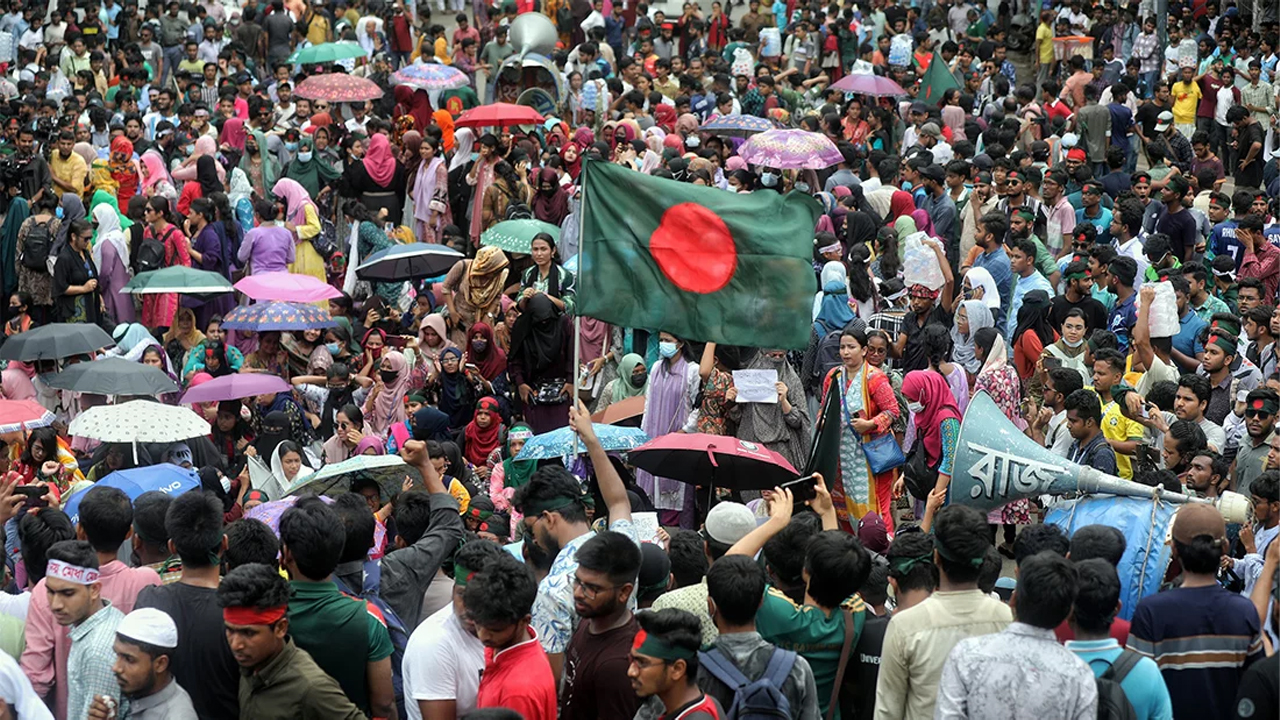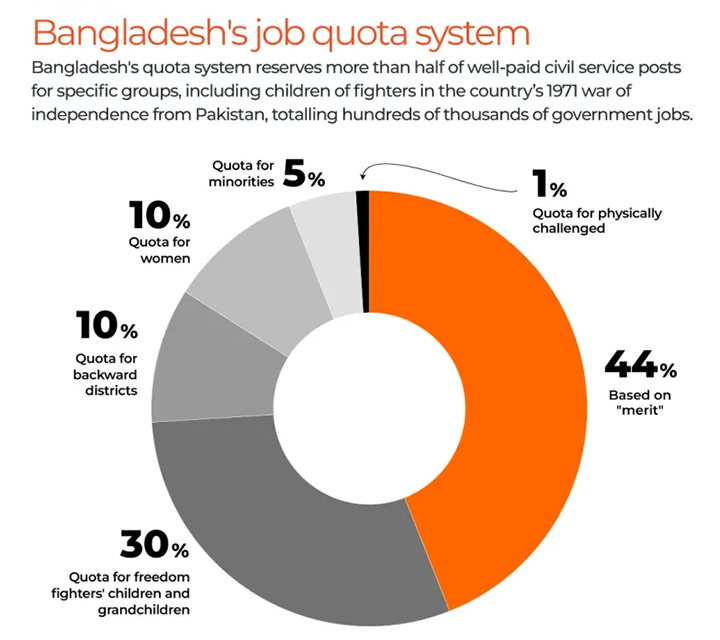Hasina must climb down from her peak of arrogance, immediately call parliament and yield to the students’ demand by scrapping the 30 percent unjust quota. She must also ensure that all those engaged in the attacks on peaceful protesters are held to account, and that an impartial, independent, and swift investigation is conducted against these attackers as well as the police officers who have perpetrated heinous crimes on the students.
Groundxero | July 17, 2024
In a ghastly display of brute state and party-cadre power, the Hasina government is literally massacring protesting students in Bangladesh. The quota-reform students’ movement turned deadly on Thursday, with at least 21 more persons — mostly protesting students — killed and hundreds injured across in Bangladesh. This is the highest toll in a single day so far in the two-week long protests rocking the universities. At least 14 deaths took place in the capital city of Dacca. Earlier, at least six people were killed in protests on Tuesday, most of which occurred near or inside university campuses. With many grievously injured, the death toll will increase further. The Bangladesh government is yet to announce any casualty figures.
The police lobbed tear gas and fired pellets and rubber bullets to break up demonstrations by student protesters, who had called a “complete shutdown” on Thursday in response to security officials’ continued attacks on the campus demonstrators. Most of those killed suffered bullet and pellet injuries fired by the police or were hacked to death with sharp weapons by armed goons belonging to the ruling party, particularly its student wing, Bangladesh Chhatra League (BCL).
Meanwhile, the representatives of the ‘Anti-Discrimination Student Movement’ coordinating the protests against the quotas in government jobs rejected the government’s proposal of discussing their demands saying negotiations could not take place amid violence and bloodshed by the forces. “We cannot trample over dead bodies to hold discussions. Discussions could have taken place earlier,” protest co-ordinator Nahid Islam told Reuters.
The government had ordered shut down of public and private universities indefinitely from Wednesday and sent riot police and paramilitary force to take control of university campuses by evicting protestors. The metro rail services in Dacca have been banned from Thursday evening. The government imposed restrictions on mobile internet access to prevent sharing of video clips of the violent crackdown.
What triggered the protests?
The protests started largely peacefully in early July after a High Court order on June 5 reinstated a controversial government job quota that reserves 30 percent of jobs in civil services for descendants of 1971 freedom fighters. 56 percent of government jobs in Bangladesh are reserved for specific groups: 30 percent for the children and grandchildren of freedom fighters, 10 percent for women, 10 percent “zila quota” for “backward” districts, 5 percent for ethnic minorities and 1 percent for people with physical disabilities.
The anti-quota student protesters are demanding the 30 percent quota for descendants of freedom fighters be abolished as they consider it unjust and socially discriminatory. This quota popularly called ‘muktijodhya quota’ was introduced in 1972, by the country’s founding father, Sheikh Mujibur Rehman, for people who fought in the 1971 war of independence from Pakistan. In 1997, as the numbers of those claiming freedom fighters quota positions started to dwindle, the government extended the quota to the children of freedom fighters and it was mentioned that if suitable candidates were not found, the posts designated for them would be kept vacant. In 2010, it was further expanded to include the grandchildren of freedom fighters. Government jobs are the only hope for many young educated people in Bangladesh, and the extension of this quota to the third generation of freedom fighter families was seen as unjust and depriving them of opportunities.
The contentious quota was suspended in 2018, following massive student protests at the time. The executive decision of the government was challenged by the relatives of the 1971 veterans in the High Court in 2021. Last month, on June 5, Bangladesh’s High Court declared the 2018 decision of scrapping quota as illegal and asked for the 30% quota for veterans’ descendants to be restored. That triggered fresh student protests, with demonstrators supporting the 6% quota for disabled people and ethnic groups but not for the children and grandchildren of the independence war heroes. There is confusion regarding their stand on the 10 percent quotas for women and “backward” districts. Many students and student organizations have categorically stated that they are not against all forms of quotas but want a reform and rationalization in the quota system.
The protesters are mainly university students. The spontaneous outburst of their anger points to their desperation in finding good and stable government jobs. While Bangladesh’s economy has grown at an average of 6.25 percent annually over the last two decades and poverty has declined considerably, the growth has not created enough jobs for the educated university students. Bangladesh’s economic rise stems largely from readymade garments (RMG) exports and remittances from workers abroad. An acute lack of jobs for university graduates is at the root of the current student unrest. Each year, some 400,000 graduates compete for 3,000 jobs in the civil service exam. The court’s order reinstating the 30 percent quota made those students come out to the streets.
Further, the quota system was misused without any fairness and transparency. The families close to the ruling party were favoured with jobs. It has helped Awami League fill the administration and bureaucracy with its supporters.
Why the protest turned violent?
The protests were peaceful with students demonstrating inside universities, and blocking highways and railway lines. Bangladesh’s top court’s temporary suspension of High Court’s order was not acceptable to the protesters. The students want to see a permanent solution to the discriminatory quota system. They announced a nationwide blockade on July 11. Many teachers also joined in these protests, forcing the academic activities of many universities to come to a complete halt. They vowed to continue their protest until their demand for a law is passed in parliament that outlaws the discriminatory quota system, is met. These protests are seen by the ruling Awami League as anti-government agitations that are being encouraged by the opposition, especially the BNP.
Major violence first erupted on last Monday at Dhaka University, where over 100 students were injured in clashes between protesters and members of the student wing of the ruling Awami League party, the Bangladesh Chhatra League (BCL).
The instigation to the violent attacks came from the Prime Minister Hasina herself. Addressing a press conference on the issue on last Sunday, she called the protesting students “Rajakars”- a derogatory term used in Bangladesh to denote those who collaborated with the Pakistani army during the 1971 liberation war in 1971. “If the grandchildren of freedom fighters don’t receive quota benefits, should the grandchildren of Razakars?” Hasina said. On Sunday night itself, thousands of students enraged at being labeled as traitors, marched through the Dhaka University campus chanting a provocative slogan that translates to, “Who are you? Who am I? Razakar, Razakar. Says who? The Autocrat. The Autocrat”. This slogan was given a twist and a vicious attack launched on the students on Monday.
The situation worsened further on Tuesday. The unrest then spread to Jahangir Nagar University outside the capital Dhaka, on Tuesday morning. Police and heavily armed members of BCL attacked the protesting students. The Police fired teargas and charged at the protesters with batons while pro-government groups attacked them with machetes, bamboo rods and hockey sticks, with a few even brandishing revolvers. Abu Sayed, a 25-year-old student, who was killed in the city of Rangpur. The police shooting 12-gauge shotguns directly at him from across the street was a reckless and unprovoked act as he standing just about 15 metres away and posed no threat to police officers. The shocking video of Abu Sayed’s cold blooded murder went viral and added fuel to the already raging fire. Six students were killed on the day.
And then came the bloodied Thursday. At least 21 persons, including young students were killed and scores injured, many riddled with rubber bullets and pellets. Unofficial sources put the death toll way above what has been reported by the media. With clashes continuing into the night, the death toll is expected to rise.
What Now?
The situation is spiraling out of control. It’s like a state that has declared war on its students. Young students are being hounded and killed. Chaos and lawlessness reigns in the capital city. What started as a democratic students’ protest has by now evolved into a full-fledged people’s uprising against the fascist Hasina regime. The moment is an opportunity for the right-wing reactionary forces to further inflame violence and plunge the country into a civil war-like situation. The onus for this lies entirely with Hasina. She has only herself to blame for allowing things to come this far.
To prevent further bloodshed, Hasina must climb down from her peak of arrogance, immediately call parliament and yield to the students’ demand by scrapping the 30 percent unjust quota. She must also ensure that all those engaged in the attacks on peaceful protesters are held to account, and that an impartial, independent, and swift investigation is conducted against these attackers as well as the police officers who have perpetrated heinous crimes on the students.


